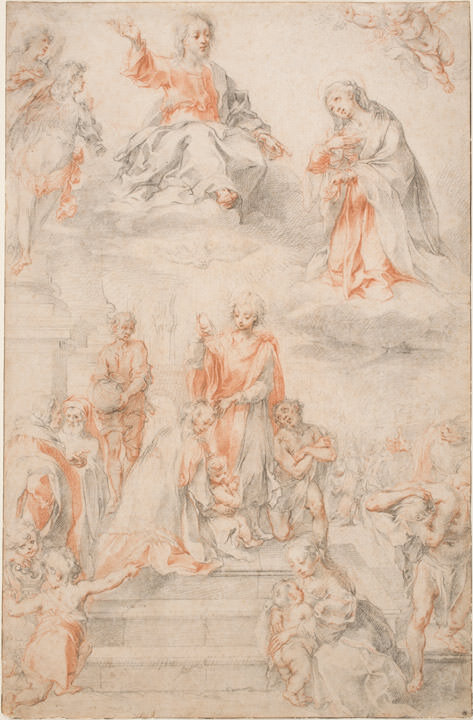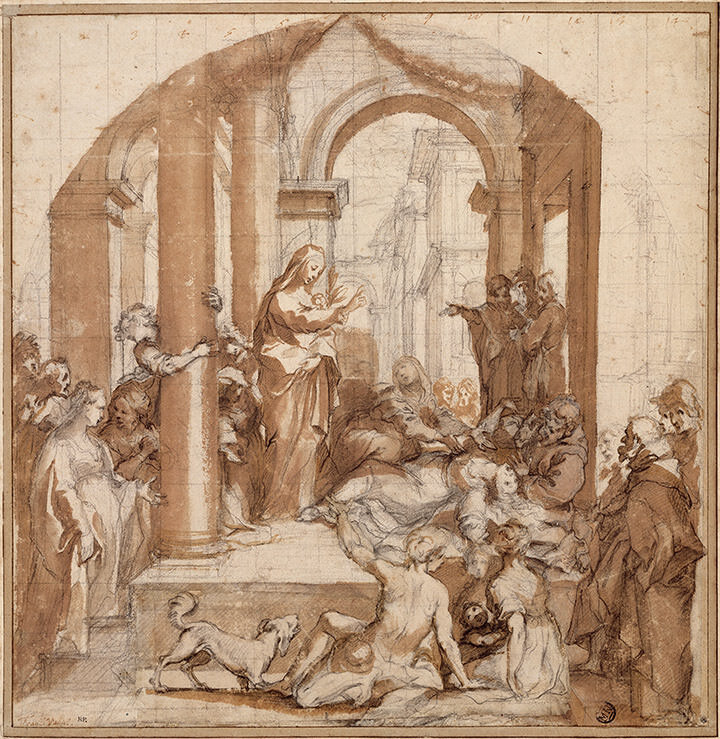September 27, 2013–January 5, 2014
The Yale University Art Gallery presents Francesco Vanni: Art in Late Renaissance Siena. Vanni (1563/64–1610) was the most important artist in Siena at the turn of the 17th century and a key figure in Italian Counter-Reformation painting. His works combine dazzling technical virtuosity and brilliant coloring with the naturalistic approach to subject matter made famous by the works of his contemporaries Annibale Carracci and Caravaggio. Vanni created altarpieces for every important church in Siena, and he also received commissions in Rome, most notably from Pope Clement VIII for a monumental altarpiece for the basilica of Saint Peter. The exhibition includes over 60 paintings and drawings by Vanni, as well as many prints following his designs, and a handful of works by related artists.
Exhibition Overview
Despite Vanni’s importance—he painted altarpieces for virtually every church in Siena and an important series of works in Rome including a monumental altarpiece for the Vatican Basilica of Saint Peter—his work has never before been the subject of a monographic book or exhibition. Most of his paintings remain in the churches of Siena and nearby towns, for which he painted them, and unfortunately many of these churches are barely or not at all accessible. The monumental altarpiece he painted for Saint Peter’s, for which he received a knighthood, is damaged and is no longer on view. In 2003, however, the Yale University Art Gallery purchased Vanni’s Madonna della Pappa, one of the artist’s most famous paintings, and this work was the inspiration for the new examination of Vanni that sits behind the exhibition. The large scale of most of Vanni’s paintings prevented their traveling to New Haven, but a small number of representative paintings, and preparatory studies for all of Vanni’s key projects, allow the exhibition and its catalogue to present a complete account of Vanni’s career.
The exhibition begins with a look at the extraordinary path by which Vanni arrived at his signature style, which is based not on the traditions of art in his native Siena, but rather on the work of Federico Barocci in Urbino and of the Carracci family in Bologna; this first part of the installation culminates with Vanni’s touching Virgin Adoring the Sleeping Child (1591), from the Santuario di Santa Caterina in Fontebranda, in Siena. A section dedicated to Vanni and printmaking follows, which looks both at the small group of etchings that Vanni produced himself, the most famous of which is Saint Francis Consoled by a Musical Angel (ca. 1595), and at the much larger body of engravings made by professional printmakers after Vanni’s designs.
A study of Vanni’s working practice—the process by which he devised a composition and worked through a range of drawings and painted studies before completing the final full-scale painting—is at the core of the exhibition. Groups of preparatory studies show the evolution of major works. The Worcester Art Museum’s Compositional Study for Saint Ansanus Baptizing the People of Siena, for example, is one of seven studies related to Vanni’s altarpiece (1593–96) in the cathedral of Siena; and the Galleria degli Uffizi’s striking red chalk Study for the Virgin and Child is one of seven studies related to Vanni’s Saint Hyacinth Saving a Drowned Boy (1596–98). The exhibition also includes one of Vanni’s finished altarpieces, the Virgin Offering the Christ Child to Saint Francis (1599), from the Museum of Art, Rhode Island School of Design, Providence—the only painting by Vanni in America other than the Gallery’s Madonna della Pappa.
Other sections of the exhibition and large sections of the catalogue focus on Vanni’s relationship with the Roman Catholic Church reform movement known as the Counter-Reformation; on Vanni’s work in Rome; and on his later career. A group of painted compositional studies including the Study for the Risen Christ Appearing to Saint Silvestro Guzzolini and a Female Saint (1607) from the Musée du Louvre, Paris, is a notable element of this final section.
The exhibition and publication were organized by John Marciari, independent curator and formerly the Nina and Lee Griggs Associate Curator of Early European Art at the Yale University Art Gallery, and Suzanne Boorsch, the Robert L. Solley Curator of Prints, Drawings, and Photographs, Yale University Art Gallery. The exhibition features loans from European institutions, including the Biblioteca Comunale, Pinacoteca Nazionale, and Santuario di Santa Caterina, in Siena; the Galleria degli Uffizi, in Florence; the Bibliothèque Nationale and Musée du Louvre, in Paris; the Rijksmuseum, in Amsterdam; the Ashmolean Museum, in Oxford; and the Fitzwilliam Museum, in Cambridge. American lenders include the Art Institute of Chicago; the Blanton Museum of Art, University of Texas at Austin; the Frances Lehman Loeb Art Museum, Vassar College, Poughkeepsie, New York; the Metropolitan Museum of Art and the Morgan Library, in New York; the Princeton University Art Museum, New Jersey; the Smith College Museum of Art, Northampton, Massachusetts; the Worcester Art Museum, Massachusetts; the Rhode Island School of Design, Providence; as well as a number of private collections.
Exhibition Catalogue
Beautifully illustrated and featuring new research, Francesco Vanni: Art in Late Renaissance Siena is the definitive resource on the artist. John Marciari investigates Vanni’s career, including his connections with patrons and his adaptation of traditional subject matter to serve the Counter-Reformation. Suzanne Boorsch explores Vanni’s engagement with printmakers and the dissemination of his compositions through prints. The catalogue examines more than 80 paintings, drawings, and prints. For more information, visit artgallery.yale.edu/publications.
Exhibition Support
The exhibition and publication are made possible by the Samuel H. Kress Foundation and an endowment created with a challenge grant from the National Endowment for the Arts.


